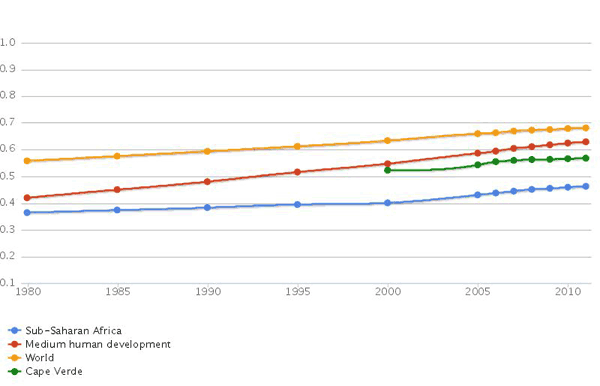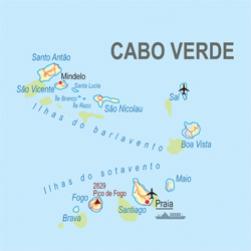Cape VerdeDownload light PDF version
Overview
As an archipelago, Cape Verde has a special position within West Africa. Sea transport to the African continent is not strongly developed and the country is mostly connected via air traffic (Cape Verde has four international and four national airports that ensure regular connections between the islands and to the rest of the world). Apart from its particular geographic position, Cape Verde is unique in many respects - culturally, economically and environmentally, and most Cape Verdeans have both African and Portuguese ancestors.
Cape Verde is also one of the few West African countries where agriculture is not the dominant sector, accounting for a mere 8 percent of GDP. Its economy is heavily dependant on remittances and tourism. Remittances account for almost USD 300 per capita in 2008 (overall GDP per capita was USD 3 264 in that same year). The Cape Verdean diaspora is estimated at some 700 000 people, as compared to a home population of only 500 000. Top destination countries are the United States, Portugal and France. Two out of three people with advanced degrees move abroad. Despite this massive exodus of the most highly educated portion of the country’s workforce, the development of Cape Verde should be considered a success story. It has already achieved most of the MDGs, and Cape Verde was moved from Least Developed Country (LDC) to Middle Income Country (MIC) status on the UN scale in 2008.
Cape Verde is also a leader in the field of renewable energy. In September 2011, the Council of Ministers approved an ambitious action plan aiming notably to i) expand the electric power grid to 100% of the territory, (ii) guarantee the supply of electricity to the entire population; (iii) use clean energy to meet 50% of the energy needs of the country; and (iv) have, at least, one of Cape Verde’s islands using solely renewable energy. Cape Verde also hosts the ECOWAS Regional Centre for Renewable Energy and Energy Efficiency (ECREEE) and the newly created West Africa Institute analysing regional integration issues in West Africa.
Institutional Framework
| Government type: | Republic |
| Constitution: | 25 September 1992; a major revision on 23 November 1995 substantially increased the powers of the president; a 1999 revision created the position of national ombudsman (Provedor de Justica) |
| Legal system: | civil law system of Portugal |
| Administrative division | 17 municipalities (concelhos, singular - concelho); Boa Vista, Brava, Maio, Mosteiros, Paul, Praia, Porto Novo, Ribeira Grande, Sal, Santa Catarina, Santa Cruz, Sao Domingos, Sao Filipe, Sao Miguel, Sao Nicolau, Sao Vicente, Tarrafal |
| Executive branch: | President Jorge Carlos Fonseca (since 9 September 2011) |
| Legislative branch: | unicameral National Assembly or Assembleia Nacional (72 seats; members elected by popular vote to serve five-year terms) elections: last held on 6 February 2011 (next to be held by 2016) election results: percent of vote by party - NA; seats by party - PAICV 38, MPD 32, UCID 2 |
| Judical branch: | Supreme Tribunal of Justice or Supremo Tribunal de Justia; Court of Audit; Military Courts; Fiscal and Customs Courts |
| Political parties: |
|
| Suffrage: | 18 years of age; universal |
| Elections: | president elected by popular vote for a five-year term (eligible for a second term); election last held on 7 August 2011 with a second round runoff on 21 August 2011; prime minister nominated by the National Assembly and appointed by the president |
| Election results: | percent of vote (second round) - Jorge Carlos FONSECA 53.4%, Manuel Inocencio SOUSA 46.6% |
| Central bank: | Banco de Cabo Verde |
| Military branches: | Armed Forces: Army (also called the National Guard), Cape Verde Coast Guard (Guardia Costeira de Cabo Verde, GCCV; includes naval infantry) (2011) |
| Military age and obligations: | 18 years of age (est.) for selective compulsory military service; 14-month conscript service obligation (2006) |
| Membership in international organisations: | ACP, AfDB, AOSIS, AU, CD, CPLP, ECOWAS, FAO, G-77, IAEA, IBRD, ICAO, ICRM, IDA, IFAD, IFC, IFRCS, ILO, IMF, IMO, Interpol, IOC, IOM, IPU, ITSO, ITU, ITUC, MIGA, NAM, OIF, OPCW, UN, UNCTAD, UNESCO, UNIDO, Union Latina, UNWTO, UPU, WCO, WHO, WIPO, WMO, WTO |
Source: CIA Factbook, Country Profile
Regional Indicators
| Land boundaries: | - |
| Border countries: | - |
| Coastline: | 965 km |
| Airports: | 9 with paved runway, 1 with unpaved runway
|
| Railways: | none |
| Roadways: | total: 1 350 km country comparison to the world: 178 paved: 932 km unpaved: 418 km (2000) |
| Ports and terminals: | Porto Grande |
Source: CIA Factbook, Country Profile
Demographic Trends
| Population 2010: | 0.5 million |
| Projection 2050: | 0.6 million |
| Population < 15 years (2010): | 157 728 (31.8% *496 000 = 157 728) |
| Population density: | 123/km2 |
| Urban agglomeration: | none |
| Annual growth: | 0.96% (2005-2010) |
| Total fertility rate (births per woman): | 2.60 (2005-2010) > 2.28 (2010-2015) |
| Median age: | 22.8 years |
| Dependency ratio: | 99 |
2010 | 2020 | 2030 | |
| <15 years (%) | 31.8 | 25.5 | 21.7 |
| 15-64 years | 62.3 | 68.4 | 69.3 |
| > 65 years | 5.9 | 6.1 | 9 |
| Rural population | 38.9 | 32.6 | 27.5 |
| Urban population | 61.1 | 67.4 | 72.5 |
Source: World Populations Prospects, 2008 Revision
Migration and Mobility
| Number of emigrants (2010): | 192 500 = 37.5% of population (other estimates much higher) |
| Number of immigrants (2010): | 12 100 = 2.4% of population |
| Top destination countries: | Portugal, France, the United States, Mozambique, Angola, the Netherlands, Senegal, Italy, Spain, Nigeria
|
| Top source countries: | São Tomé and Principe, Angola, Guinea-Bissau, Portugal, Senegal, Italy, the United States, France, Nigeria, Brazil |
| Refugees within country: | - |
Economic Indicators
| GDP PPP (2010): | USD 2 147 million |
| % of West Africa | 0.4% |
| GDP per capita: | USD 4 188 |
| Annual growth (2009): | 3.6% |
| Average growth (2002-2012): | 6.1% |
| Currency | Cape Verdean escudos (CVE) |
| WB Income group: | Lower-middle income |
| Inflation rate: | 1.2% (2009) |
| Trade balance | - USD 630 million |
| FDI inflows (2009): | USD 120 million |
| External debt (2009): | USD 1 029 million |
| Debt service (as % of exports 2010e): | 21.7% |
Public finance (% of GDP 2009): |
|
| Main exports: | Fuel, shoes, garments, fish, hides |
| Main imports: | Foodstuffs, industrial products, transport equipment, fuels |
| Main export partners: | Spain (52.1%), Portugal (21.5%), Morocco (6.9%) (2009) |
| Main import partners: | Portugal (43.5%), the Netherlands (15.1%), Spain (5.9%), China (5%), Italy (4.3%), Brazil (4.1%) |
| Labour force participation (2008): | 66.2% Female; 82.7% Male |
| Child labour (% of children ages 5–14) 1999–2007: | 3% |
| Diaspora Remittances 2009e: |
|
ODA received: |
|
Military expenditures: |
|
| IMF Adjustment Programme | |
| Corruption Perception Index (2010): | 5.1 (rank 45 out178 countries) |
| Index of Economic Freedom 2011: | 64.6 (rank 65 out of 179 countries) |
| WB Doing Business Index (2011): | Rank 119 out of 183 countries |
| Ibrahim African Governance Index (2011): | 2nd out of 53 countries |
Sources: African Economic Outlook - CIA Factbook - respective indexes
Food Security
| Global Hunger Index (IFPRI): | - |
| Food supply (kcal per capita/day) | 2 549 |
| Number of people undernourished: | - |
:Percentage of people undernourished: | - |
| Child malnutrition, underweight: | - |
| Child malnutrition, stunting: | - |
Land use
| Land area (1 000 ha): | 403 |
| Agricultural land area (1 000 ha): | 88 |
Arable land (1 000 ha): | 65 |
| Permanent crops (1 000 ha): | 3 |
| Pastures (1 000 ha): | 25 |
| Irrigated land (1 000 ha): | 3 |
| Share in total water use by |
|
| Forest area (1000 ha): | 85 |
Source: FAOStat and FAO Country Profile
MDG Tracking


